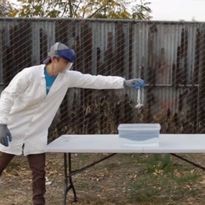In Mosa Mack’s Atoms and Molecules unit, students solve two atomic mysteries through which they discover the components of molecules and atoms. They are then led through an activity in which they construct atomic and molecular models. The unit culminates in an element challenge in which students select an element and bring it to life by either creating a profile for it or designing a product based on it.
- Lesson 1

The Solve: Exploding Substances + Atomic Mystery
Choose to solve either a live video mystery on why two mystery substances behave so differently or an animated mystery on what caused a cook's dessert to fail so badly. By the end of The Solve, students discover that substances that may look the same to the human eye can have very significant chemical and physical differences. (Live Solve: 70-90 minutes; Animated Solve: 80 minutes)
- Lesson 2

The Lab: Atomic Modeling
Learners engage in the hands-on modeling activity of showing different atomic combinations, leading to different molecular properties (150 minutes)
- Lesson 2

The Lab Extension: Conservation of Matter
Students will investigate a chemical reaction produced in a lava lamp experiment to determine if mass is conserved. They then will use Lego bricks to model the chemical reaction in order to further analyze if the number and types of atoms that make up the products are equal to the number and types of atoms that make up the reactants. (150 minutes)
- Lesson 3

The Engineer: Design an Element Character
Choose from two options! 1. Students select an element from the Periodic Table, research its chemical and physical properties, and design a character from their element research OR 2. Students select an element or compound, research its chemical and physical properties, and design a new product or futuristic material. (150 minutes)






